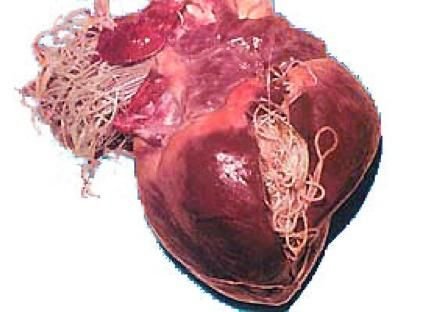DIROFILARIA IMMITIS -It is a species of round worm (nematode), a specific parasite of dogs and other canids (foxes, coyotes, wolves, etc.), but which can also infect cats and very occasionally humans. -It occurs in temperate and warm regions: North America to Canada and Latin America, Europe, Southeast Asia, the Middle East, Australia and Japan. -The disease is transmitted by the bite of mosquitoes, not by direct or indirect contact with pets, their feces, vomit, etc.

LOCATION
-The preferred organs of the adults of Dirofilaria immitis are the pulmonary arteries and the right ventricle of the heart. The larvae can be found in the skin, the thoracic and abdominal muscles and in the blood.
DESCRIPTION
- The adults of Dirofilaria have the typical round worm shape and can reach up to 30cm in length and 1-2mm in thickness. The larvae (microfilariae) are a few mm long. The females are viviparous, that is, they do not lay eggs, but they develop into larvae in the uterus.
SYMPTOM
- Inappetence, loss of weight, languor, cough, dyspnea (difficulty in breathing), fatigue before exercise and accumulation of fluids in the abdomen (ascites) can be observed.
.
.
.
(SPANISH)
DIROFILARIA IMMITIS -Es una especie de gusano redondo (nematodo), parásito especifico de los perros y otros cánidos (zorros, coyotes, lobos, etc), pero que también puede infectar a gatos y muy ocasionalmente a seres humanos. -Se da en regiones templadas y cálidas: América del norte hasta Canadá y América latina, Europa, Sudeste asiático, Medio oriente, Australia y Japón. -La enfermedad se transmite por la picadura de los mosquitos, no por contacto directo o indirecto con las mascotas, sus heces, vomito, etc.

LOCALIZACIÓN
-Los órganos predilectos de los adultos de Dirofilaria immitis son las arterias pulmonares y el ventrículo derecho del corazón. Las larvas pueden hallarse en la piel, músculos toracicos y abdominales y en la sangre.
DESCRIPCIÓN
-Los adultos de Dirofilaria tienen la típica forma de gusano redondo y pueden alcanzar hasta 30cm de longitud y 1-2mm de espesor. Las larvas (microfilarias) miden pocos mm de longitud. Las hembras son vivíparas, es decir, no ponen huevos, sino que estos se desarrollan a larvas en el útero.
SINTOMAS
-Puede observarse inapetencia, perdida de peso, languidez, tos, disnea (dificultad en la respiración), fatiga ante el ejercicio y acumulación de fluidos en el abdomen (ascitis).
Congratulations @jvasquez1192! You received a personal award!
You can view your badges on your Steem Board and compare to others on the Steem Ranking
Vote for @Steemitboard as a witness to get one more award and increased upvotes!
Downvoting a post can decrease pending rewards and make it less visible. Common reasons:
Submit